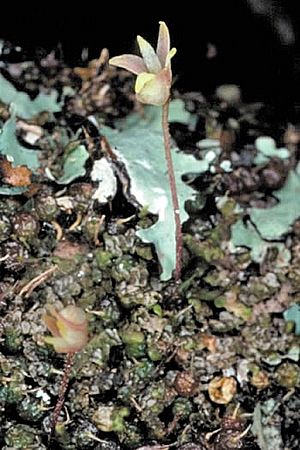Green bead orchid facts for kids
Quick facts for kids Green bead orchid |
|
|---|---|
 |
|
| Conservation status | |
| Scientific classification | |
| Genus: |
Bulbophyllum
|
| Species: |
globuliforme
|
| Synonyms | |
|
Oncophyllum globuliforme (Nicholls) D.L.Jones & M.A.Clem. |
|
The green bead orchid (Bulbophyllum globuliforme) is a super tiny and unique orchid that grows on trees! It's also known as the miniature moss-orchid or hoop pine orchid because it's so small it can look like moss. This special plant lives mostly on the McPherson Range in eastern Australia, right on the border between New South Wales and Queensland.
Contents
What Does It Look Like?
The green bead orchid is an epiphytic plant. This means it grows on other plants, like trees, but doesn't harm them. It has pale green, round parts called pseudobulbs. These pseudobulbs are only about 1 to 2 millimeters (0.04 to 0.08 inches) wide.
Each pseudobulb has a single, thin, scale-like leaf. This leaf is also very small, about 1 to 2 millimeters long.
Its Flowers
This orchid grows a single, cream-coloured flower. The flower is about 3 millimeters (0.1 inches) long and 3 to 5 millimeters (0.1 to 0.2 inches) wide. It sits on a thin stem that is about 10 to 15 millimeters (0.4 to 0.6 inches) long.
The flower has parts called sepals and petals that spread out wide. The sepals are about 3 millimeters long, and the petals are about 2 millimeters long. It also has a yellow labellum, which is a special lip-like part of the orchid flower.
You can usually see these tiny flowers from September to November and again from May to August.
How It Was Named
The green bead orchid was first officially described in 1938. A botanist named William Nicholls gave it its scientific name, Bulbophyllum globuliforme.
Where It Lives
The green bead orchid grows on the rough bark of a tree called the hoop pine (Araucaria cunninghamii). It prefers to live in rainforests. You can find it mainly on the McPherson Range in eastern Australia.
Protecting This Orchid
This special orchid is considered "vulnerable" by the Australian Government. This means it's at risk of disappearing if we don't protect it. In New South Wales, it's also listed as vulnerable. In Queensland, it's called "rare," which also means it needs protection. Efforts are made to help this tiny, unique orchid survive and thrive in its natural home.
See also
 In Spanish: Bulbophyllum globuliforme para niños
In Spanish: Bulbophyllum globuliforme para niños


